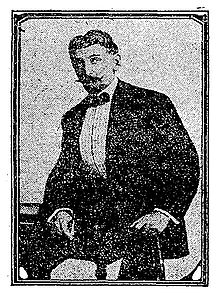
Ira Thompson Van Gieson (1866, Long Island – March 24, 1913, New York City) was an American neurologist, psychiatrist, bacteriologist and neuropathologist.
Ira was born in Long Island in 1866, as the son of Dr. Ransford Everett Van Gieson (1836–1921). He was of Dutch-Jewish heritage.[1][2] The "Van" is from Dutch "van ("of" or "from"), anglicized with a capital V. Ira Van Gieson graduated from the College of Physicians of Columbia University in 1885. In 1887, he served as a teacher at the college of physicians and surgeons and in 1894 he was appointed instructor of pathology and histology of the nervous system.[3]
In 1896, he was appointed as first director of the Pathological Institute of the New York State Hospitals for the Insane (renamed New York State Psychiatric Institute in 1929). He was dismissed after five years because of political controversy involving the newly appointed president of the NY State Commission on Lunacy, Peter Wise.[4][5] As a result, the whole Institute's faculty resigned[6] and in 1900 a formal "Protest of the Friends of the Present Management of the N.Y. Pathological Institute" was signed (S. Weir Mitchell, James J. Putnam, Percival Bailey, Morton Prince, Frederick Peterson, and many others).[7] After dismissal, he returned into the service of the New York State Health Department. He practised hypnosis and occasionally served as a forensic psychiatrist.[8][9]
He died at the age of 47 at the Bellevue Hospital, NY, on March 24, 1913.[10] He suffered from chronic nephritis.[3]
His obituarist, William Alanson White, wrote:[11]
"Dr. Van Gieson can best be described in a few words as a genius. He knew none of the rules that applied to the average man. He had a keen and incisive mind, he was alert and full of interest in everything, but he possessed that sensitive organization which made anything approaching control from outside sources utterly unsupportable. He was a spasmodic and irregular worker, when he worked, working with a fervor and depth of distraction that made him utterly forget time, food and, sleep, working for days and days without rest, way into the small hours of the morning. These periods of tremendous activity were followed by days of inactivity, during which he did nothing, and sometimes was entirely inaccessible, not even attending his office. He was, however, tremendously productive."
Van Gieson introduced the picric acid stain (Van Gieson's stain) to neurohistology in 1889.[12] He coined the term "psychomotor epilepsy".[13]
He collaborated with Boris Sidis,[14] Bernard Sachs,[15] and others.
- ^ Roizin L (August 1970). "Van Gieson, a visionary of psychiatric research". The American Journal of Psychiatry. 127 (2): 180–5. doi:10.1176/ajp.127.2.180. PMID 4919636.
- ^ H C Cook (September 1997). "Origins of ... tinctorial methods in histology". J Clin Pathol. 50 (9): 716–720. doi:10.1136/jcp.50.9.716. PMC 500167. PMID 9389971.
- ^ a b Kelly, Howard Atwood (1920). A Cyclopedia of American Medical Biography: Comprising the Lives of Eminent Deceased Physicians and Surgeons from 1610 to 1910. W.B. Saunders Company.
- ^ John M. Oldham, Michelle B. Riba: American Psychiatric Press Review of Psychiatry. American Psychiatric Pub, 1994 ISBN 0880484403 p.39
- ^ Jay Schulman: Remaking an Organization: Innovation in a Specialized Psychiatric Hospital. SUNY Press, 1969, ISBN 0-87395-041-0 pp. 122–129
- ^ Institute's Faculty Resigns. New York Times May 1, 1901, PDF
- ^ Lanska, Douglas J. (2002). "Classic Articles of 19th-Century American Neurologists: A Critical Review". Journal of the History of the Neurosciences. 11 (2): 156–173. doi:10.1076/jhin.11.2.156.15196. PMID 12122807. S2CID 34469937.
- ^ HYPNOTISM TEST IN HITCHCOCK CASE; Doctor Tells of Putting Woman Under a Spell, in Which She Revealed Story of Shooting. The New York Times (September 1, 1908) PDF
- ^ Hypnotic Defense Flaws. The New York Times (September 2, 1908) PDF
- ^ Obituary. New York Times March 25, 1913 PDF
- ^ White WA. "Dr. Van Gieson, An Obituary," American Journal of Insanity, 69 (January 1913), 801–03
- ^ van Gieson I (1889). "Laboratory notes of technical methods for the nervous system". N Y Med J (50): 57.
- ^ Hans Lüders, Youssef G. Comair: Epilepsy Surgery. Lippincott Williams & Wilkins, 2000 ISBN 0-7817-1442-7 p. 95
- ^ Robert W. Rieber, Flora Rheta Schreiber: The Bifurcation of the Self: The History and Theory of Dissociation and Its Disorders. Birkhäuser, 2006 ISBN 0-387-27413-8 p. 28
- ^ Robert J. Desnick, Michael M. Kaback: Tay–sachs Disease. Academic Press, 2001 ISBN 0-12-017644-0 pp. 13–14
